Affiliate links on Android Authority may earn us a commission. Learn more.
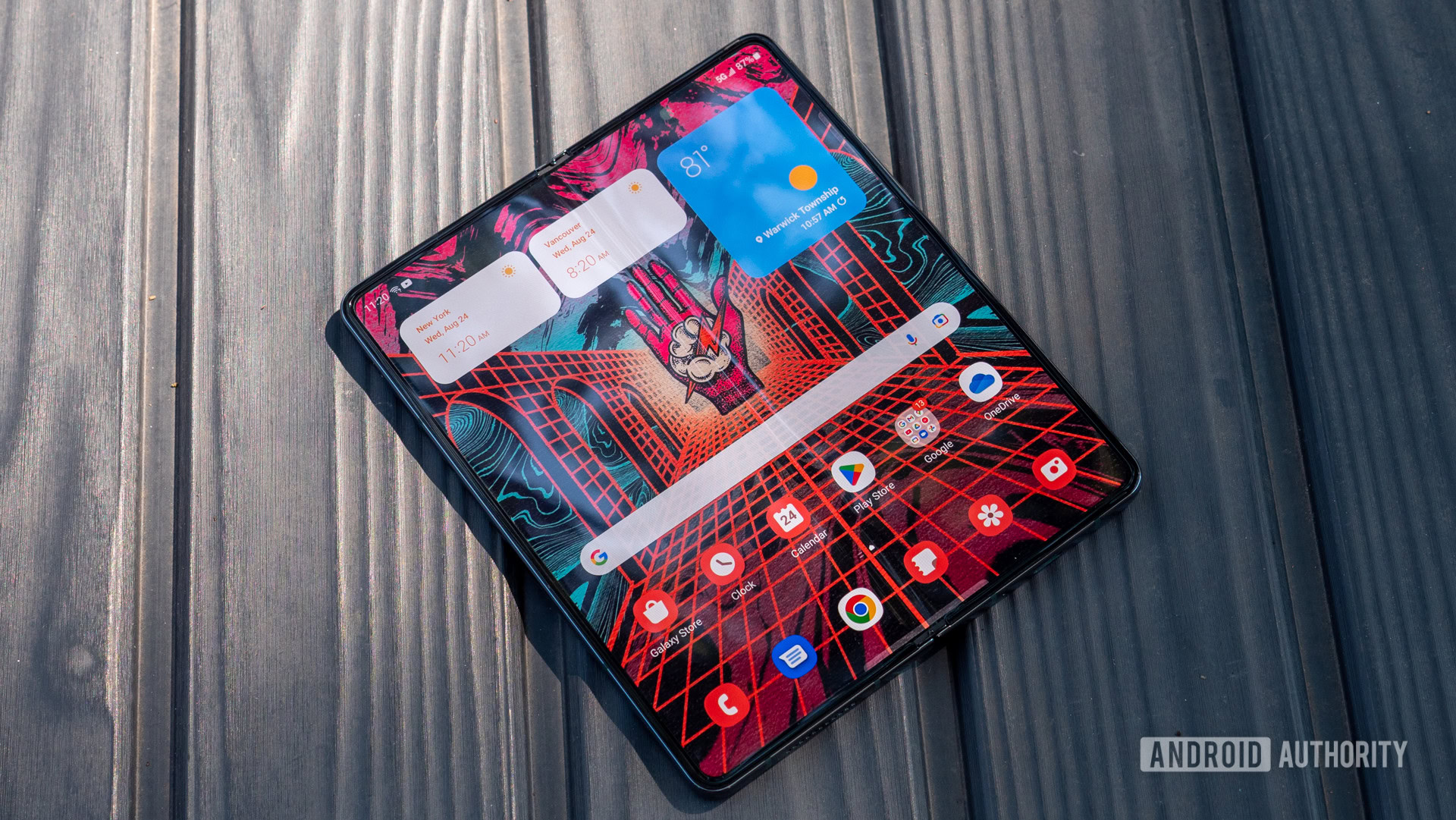


Samsung Galaxy Z Fold 4
What we like
What we don't like
Our scores

Samsung Galaxy Z Fold 4
Samsung’s message throughout 2022 was loud and clear: refine, don’t rebuild. We saw it with the flagship Galaxy S22 and S22 Plus, the mid-range Galaxy A53 5G, and even its Galaxy Watch 5 series smartwatches — all products that stuck to familiar forms with only subtle changes inside and out. Not even Samsung’s ultra-premium, ultra-expensive Galaxy Z Fold 4 escaped the trend, but are minor steps enough for the cutting-edge of smartphone technology? Find out in our Samsung Galaxy Z Fold 4 review.
Update, August 2023: We’ve added information on the latest alternatives and software updates.
What you need to know about the Samsung Galaxy Z Fold 4
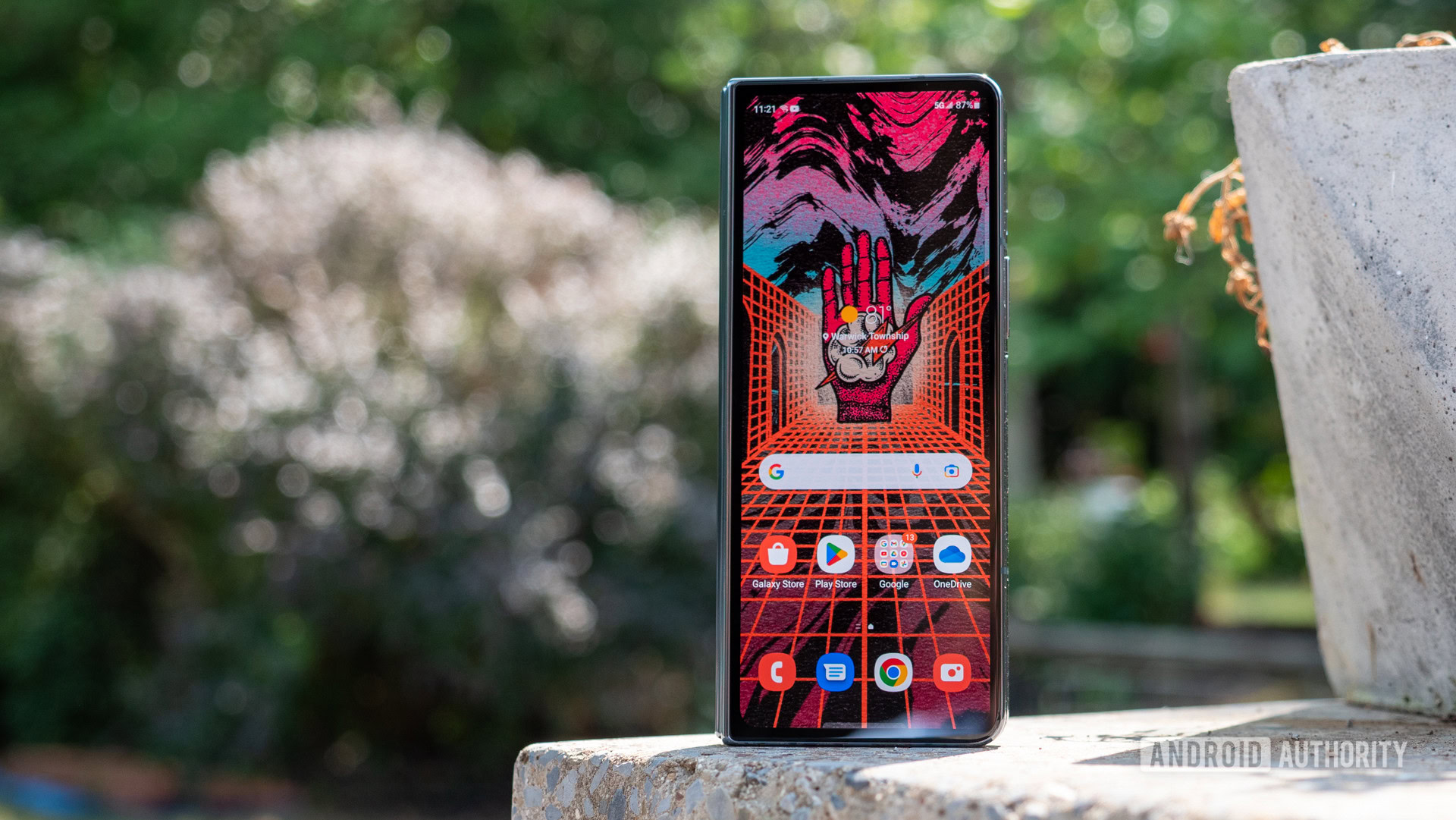
- Samsung Galaxy Z Fold 4 (12GB/256GB): $1,799 / £1,649 / €1,799
- Samsung Galaxy Z Fold 4 (12GB/512GB): $1,919 / £1,769 / €1,919
- Samsung Galaxy Z Fold 4 (12GB/1TB): $2,159 / £2,019 / €2,159
Samsung introduced the Galaxy Z Fold 4 alongside the Galaxy Z Flip 4 as part of the August 2022 Unpacked event. It succeeds the Galaxy Z Fold 3 in a way that can only be described as the apple not falling far from the tree. The book-style foldable’s overall design is almost identical to that of its predecessor, save for a few millimeters and grams shaved here and there.
Starting from the outside, the Galaxy Z Fold 4 still packs a 6.2-inch AMOLED display, complete with a 120Hz dynamic refresh rate. It’s a bit sharper and a fraction wider than the external display on the Galaxy Z Fold 3, and the central 10MP punch hole camera remains the only interruption. Samsung’s external display is ringed by an Armor Aluminum frame with a new, glossier finish for 2022. The durable external package also retains its IPX8 rating for water resistance, while the outer display is now covered by Gorilla Glass Victus Plus.
The Galaxy Z Fold 4's design and construction are as refined as ever, but most of the upgrades lie under the hood and within the rear camera module.
Once you crack open that tough shell, you’re greeted by another crisp AMOLED panel, this time measuring 7.6 inches across the diagonal and cover with Samsung’s latest generation, proprietary Ultra Thin Glass tech. The resolution is once again a little sharper than its predecessor and is combined with a 120Hz dynamic refresh rate, up to 1,200 nits of peak brightness, and a slightly improved 90.9% screen-to-body ratio (up from 88.8%) due to its marginally boxier aspect ratio. The Galaxy Z Fold 4’s internal display is only marred by the second-generation 4MP under-display selfie camera, though it’s far less visible than the one found on the previous model.
Thankfully, Samsung finally furnished the Galaxy Z Fold 4’s rear camera module with some much-needed upgrades. It now sports almost the same trio of shooters as the tried-and-tested Galaxy S22 and Galaxy S22 Plus — a 50MP main lens, 10MP telephoto, and 12MP ultrawide. They’re still nestled in the corner of the back panel (also Gorilla Glass Victus Plus), but each lens has a glossy ring to match the phone’s frame.
Under the hood, the Galaxy Z Fold 4 packs Qualcomm’s late-2022 flagship silicon — the Snapdragon 8 Plus Gen 1 processor — backed by 12GB of RAM and up to 1TB of non-expandable storage. A familiar 4,400mAh battery provides the juice to keep the productivity powerhouse going, with 25W wired charging and 10-15W wireless charging to top it back up again.
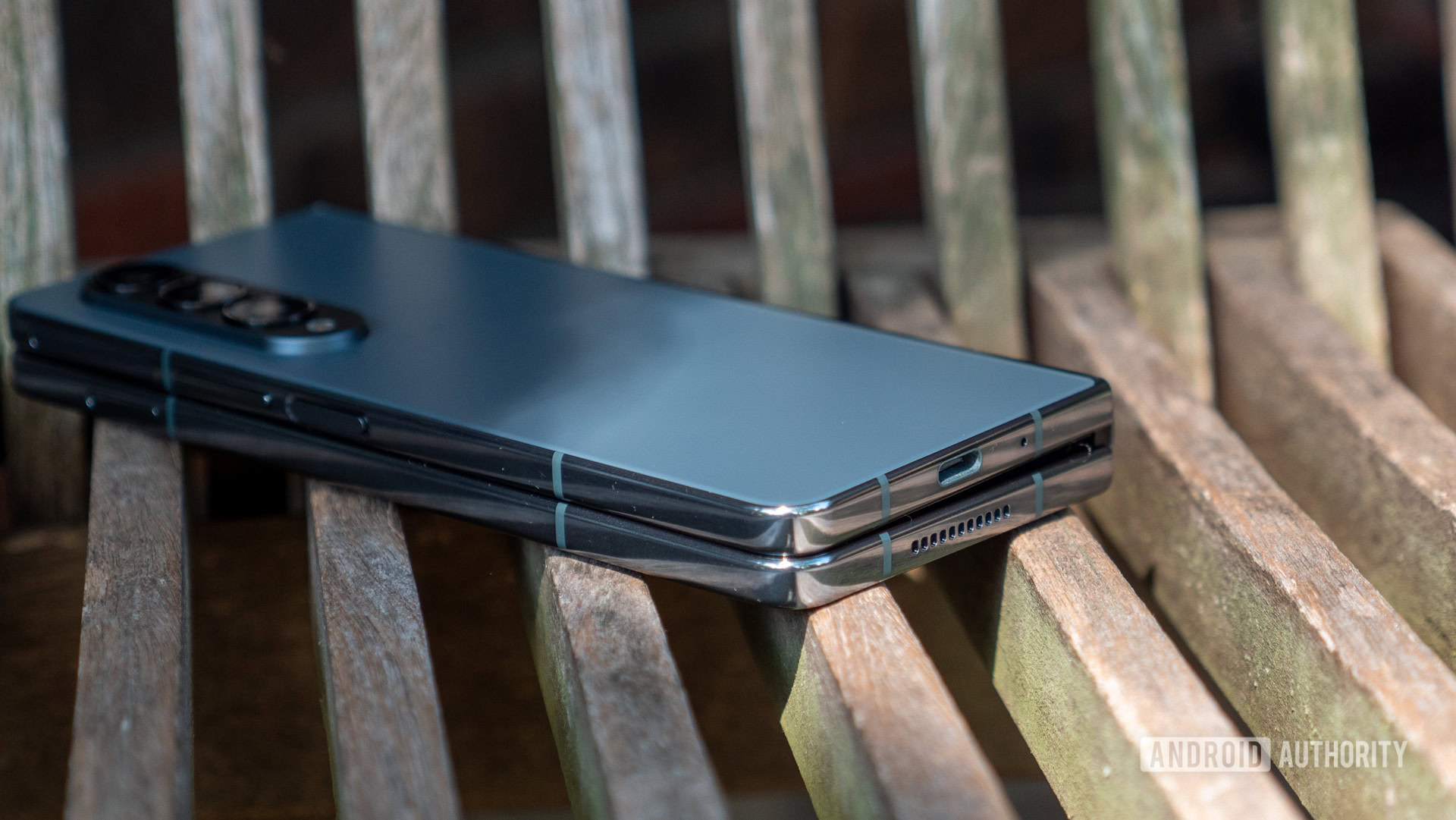
While Samsung’s first few Fold devices packed plenty of packaging goodies, the Galaxy Z Fold 4 is yet another sign of the times. It comes in a very thin box, accompanied only by paperwork, a SIM ejector tool, and a USB-C cable.
Although it’s bound to remain a leader in the premium foldable game in North America, where it remains unchallenged, Samsung’s Galaxy Z Fold 4 faces more international competition than ever. OPPO, for example, recently released its Find N2, which improves on the book-style foldable with a smaller, more pocketable design. It also nearly eliminates the display crease — something that Samsung has long struggled with. HONOR has also upgraded its folding game with the Magic Vs, a slightly more affordable foldable that’s not just limited to the Chinese market. Even Xiaomi announced its Mix Fold 2 right around the time the Galaxy Z Fold 4 launched, showing that Samsung can’t corner the market quite as easily these days. Samsung has also released a successor in the Galaxy Z Fold 5, which eliminates the hinge gap and bumps up to the latest Snapdragon 8 Gen 2 for Galaxy processor.
The Galaxy Z Fold 4 went on sale on August 26 and is available to buy online in the US at Samsung, Amazon, Best Buy, and more. It comes in four different colors: Graygreen (pictured), Phantom Black, Burgundy, and Beige.
Has the design changed at all?
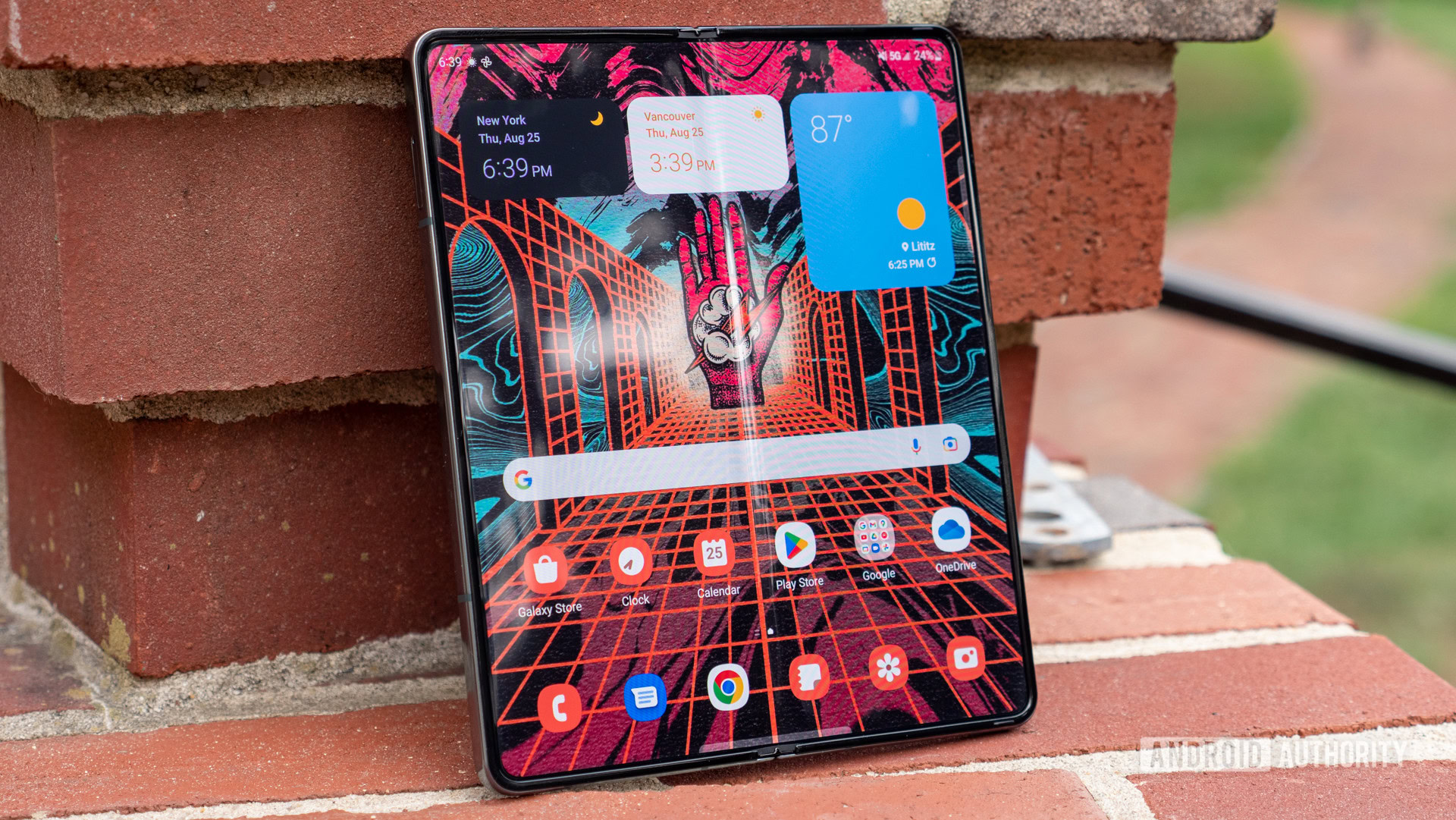
Without holding the Galaxy Z Fold 3 in one hand and the Galaxy Z Fold 4 in the other, you’d be hard-pressed to say the design has changed. Even if you have both phones at your disposal (like we do), it’s still tricky to pick them apart. Much like the Galaxy Z Flip 4 — its clamshell-shaped sibling — the Galaxy Z Fold 4’s external changes come down to a few millimeters here and there. If you want a slightly updated design, the Galaxy Z Fold 5 packs a new hinge that’s a bit thinner and eliminates the gap between the two halves of the display when closed.
More specifically, the Samsung Galaxy Z Fold 4 is 3mm shorter and 2mm wider than its predecessor when unfolded. When closed, there’s no difference in width at all. It’s also 8g lighter, though it’s still a heavy boy at 263g (9.28oz). All of the buttons and ports are in familiar places, as well. The capacitive fingerprint reader and volume rocker lie on the far right when open or closed, while the USB-C port is on the bottom edge of the right half when open. Over on the left half, you’ll find top-firing and down-firing speakers that create stereo sound.
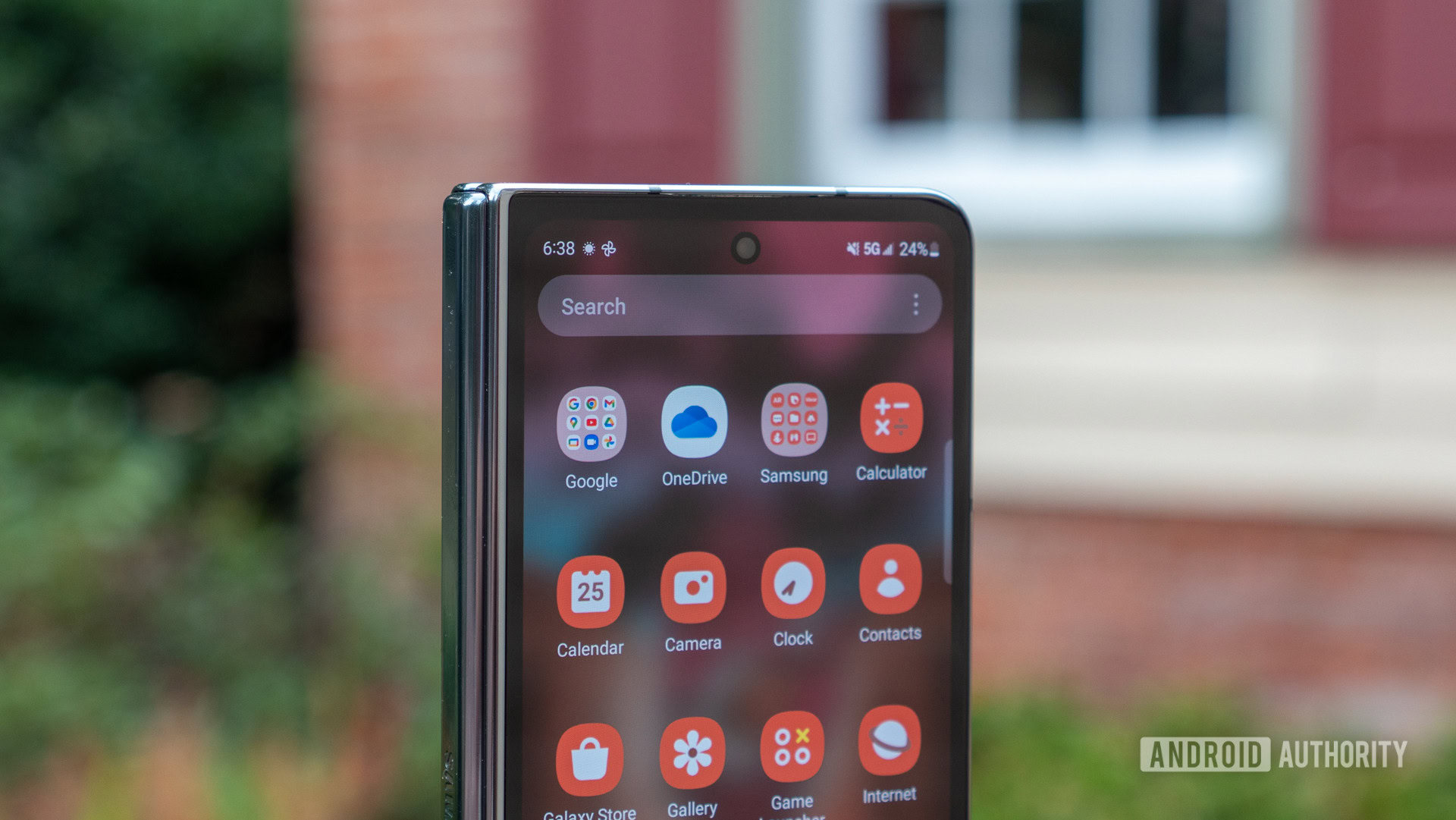
While the tablet-sized screen within remains the phone’s central gambit, the outer display is where you’ll actually run most of your tasks if you’re using the Galaxy Z Fold 4 on the go. The 6.2-inch external AMOLED panel remains tall and thin, like a starting point guard. Despite having the same diagonal measurement as its predecessor, the shorter overall device height means that the bezels lost a little weight. The thinner bezels provide a few extra pixels of width compared to the Galaxy Z Fold 3, resulting in a mildly less skinny 23.1:9 aspect ratio — closer than ever to the dimensions of a regular slab phone’s display and far nicer to use as a result.
None of this impacts the cover screen’s selfie camera position, which is front and center and surrounded by a small black ring. You can also feel the slimmer bezels on the internal display, as the 2mm trim comes courtesy of Samsung’s reimagined hinge. The difference isn’t massive, but the Galaxy Z Fold 4 is a story of little progress.
If you’ve never used one of Samsung’s Galaxy Z Fold devices before — and many haven’t — the form factor will take some getting used to. I had no problems using it one-handed while folded, but it becomes nigh-on impossible once you open the device. Wrangling the 7.6-inch behemoth in a single palm feels like holding a dish of ice cream and trying to spoon it into your mouth with the same hand. You might get a scoop here and there, but you’ll enjoy it a lot more if you just eat it properly.
The wider aspect ratios may be slightly more manageable, but the Galaxy Z Fold 4's size and shape still demands two-handed use.
Once you embrace the two-handed approach, you’ll find the easiest way to approach the Galaxy Z Fold 4’s internal display is to use it as if you were using a traditional Android tablet. However, tablets don’t force you to muddy up a rear display with fingerprints. If you prefer to scroll and navigate with your right hand, as I do, you’ll end up with plenty of smudges on the cover screen when using the device unfolded. They’re easy enough to wipe off but can drive you crazy as you switch between the two modes.
After getting used to the book-like form factor, it doesn’t take long to really appreciate the might of the internal display. The massive panel’s boxier aspect ratio makes it more square than ever and, in turn, more pleasant to use when immediately folded open in its portrait orientation. It can get very bright at up to 1,200 nits, and the color recreation is excellent. Meanwhile, the 120Hz adaptive refresh rate is delightfully smooth and can drop to as low as 1Hz when viewing static content to reserve battery. Sadly, the crease in the middle of the folding display is anything but smooth — you won’t glide your finger over it as much as you would with the Galaxy Z Flip 4’s horizontal dip, but it’s still there and it’s still noticeable if you catch the light in the wrong position.
While Samsung hasn’t solved its crease problem, it has managed to hide one blemish on the book display; the under-display selfie camera is immediately less obvious than the Galaxy Z Fold 3’s pixelated blob thanks to a new scatter-type sub-pixel arrangement. The results from the camera remain fairly awful (we’ll get to that), and you’ll still notice it on white or light-colored backgrounds, but it blends far more nicely into darker shades.
Samsung’s premium sandwich of materials means that the Galaxy Z Fold 4 is about as tough as a foldable phone can be. The Gorilla Glass Victus Plus outer display and rear panel combine nicely with the color-coordinated Armor Aluminum frame, while the Ultra Thin Glass internal display is more durable than before, according to Samsung. It’s internally tested for up to 200,000 folds, though most people will never come close to that number. Samsung also claims it has applied improved adhesive to the necessary protective film that covers the internal display. We’ll have to wait and see if this holds up over time, but in the meantime, just make sure you do not remove this screen protector as you’ll immediately leave the entire display vulnerable to dust particles and potentially create air bubbles.
The IPX8 rating also returns, so the Fold can still handle water, but it’s best kept far away from dust — though it’ll somehow still accumulate in the crease.
How do the new cameras perform?

One of the Galaxy Z Fold 4’s best hardware upgrades is one that you’re not likely to notice just by looking at the device. It packs a trio of rear cameras with two being borrowed from the Galaxy S22 and S22 Plus — specifically the 50MP main shooter (which bins to 12.5MP by default) and the 10MP 3x optical telephoto lens. These are flanked by a 12MP ultrawide camera that remains the same as the equivalent Galaxy Z Fold 3 sensor. If you’re not into binned images, you can also set the primary camera for full-size shots as needed.
Samsung regulars might recognize that the 3x telephoto shooter is one of the primary requirements for Expert RAW support. Like its predecessor, the Galaxy Z Fold 4 supports Expert RAW for in-depth camera controls and RAW file exports if you want to get into the weeds of editing — something that’s far easier on that large internal display compared to a regular smartphone.
The Galaxy Fold series can finally compete with the best camera phones in the world.
When it comes down to it, though, almost nobody will use the Galaxy Z Fold 4’s cameras with the phone unfolded. The size and shape make you feel like “that person” trying to use an iPad to record your child’s recital. Besides, it’s much easier to get a rock-solid grip on the phone when it’s closed, all but eliminating the blur from any shaky hands you might have. However, if you’re determined to give the rear cameras a shot with the phone open (you monster), Samsung will treat you to a unique layout option, as seen below. It turns one half of the display into a record of your last few images while the other half acts as your viewfinder and shutter button.
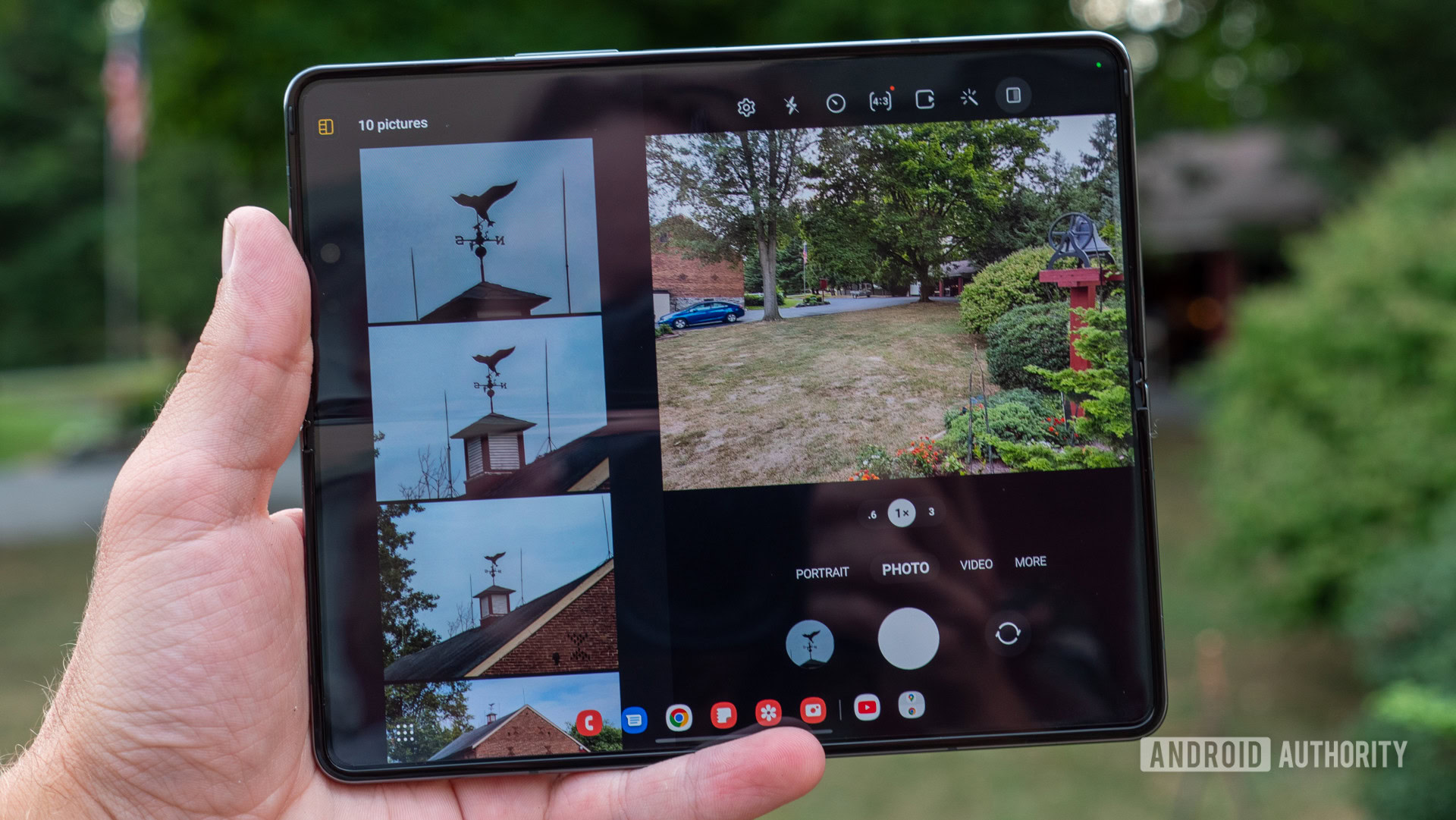
Regarding performance, we already mostly know what to expect thanks to the Galaxy S22 and Galaxy S22 Plus — two of the best camera phones you can find outside of the ultra-premium sphere. Aside from the ultrawide and a few millimeters of focal length on the telephoto lens, the setups are essentially identical. While we’re not quite in the rarified air of Galaxy S22 Ultra territory, the adoption of an already-capable camera setup fixes what was a clear sore point on previous Galaxy Z Fold devices.
Case in point: the Galaxy Z Fold 4’s shared 50MP shooter performs well in just about every situation. I never had any problems capturing detail, and the natural bokeh, as seen in the picture of pink flowers, is beautifully smooth. The color recreation tends to fall on the saturated side, but I found the Galaxy Z Fold 4 offered slightly more natural shades than its Flip counterpart. Images where you can see the sky, like the set of American flags, still show good detail in the clouds without being blown out in terms of exposure.
The Galaxy Z Fold 4’s ultrawide camera keeps distortion to a relative minimum at 0.6x, though it does have a wider field-of-view at 123 degrees than the Galaxy S22 and Galaxy S22 Plus (120 degrees). As a result, you get a bit of stretch and curvature around the edges, as you can see in the image of the barn below. The returning ultrawide sensor also adopts a different color profile compared to the main camera, with red and green shades appearing slightly lighter than they truly are.
The new telephoto lens offers up to 3x optical zoom (up from 2x on the Z Fold 3), with the option to combine digital enhancement for up to 30x zoom — or what Samsung calls “Space Zoom.” However, you won’t notice any 30x zoom samples below, as despite Samsung’s love of marketing it, the results are rarely usable. Shots up to 10x zoom and sometimes even 20x zoom are often better, though you’ll start to see heavy post-processing for the latter. The image of the cupola and the clock tower preserve good detail and clarity at 10x, so long as you don’t crop in too closely. The colors, at least on the cupola, are darker than in actuality, but that may be partially down to the evening lighting.
Portrait mode is accurate for the vast majority of subjects as well. It identified edges accurately in most of my shots, but the degree to which the Galaxy Z Fold 4 applies its bokeh can vary in auto mode. For example, the portrait of a horse — taken at 3x zoom — has a much softer background than the snap of a corgi. Both are easily distinguishable as the subject, and the colors are punchier than in standard images, but the corgi’s background isn’t quite as dreamy.
There are also a few instances where portrait mode swung and missed almost entirely. I focused on the hanging fern to the left, and it got a nice color boost, but there’s next to no fade behind it. The same goes for the statue of the man reading his paper — you could easily pass the background off as natural bokeh rather than portrait mode.
Like portrait mode, Samsung’s night mode results are a mixed bag. Images tend to come out best in moderately lit situations, like the patriotic wooden figure below, yet like so many camera phones, it struggles in very dark scenarios, like the image to the center-right. I attempted to take a picture of my friends watching a movie in a barn, but you can only make out some sections of the wood frame.
My sample image of The Beatles Lego minifigs and their blocky yellow submarine was captured in an almost entirely dark room and, in my opinion, shows the best of what night mode has to offer. It captured accurate colors for the submarine and the shrunken fab four, even if a few of the black books behind them bleed together.
The Samsung Galaxy Z Fold 4’s primary 10MP selfie camera — nestled within the cover display’s punch hole — is still a solid shooter. It’s not up there with the Galaxy S22 Ultra’s premium lens, but it delivers good color and decent detail in the background. I noticed it missed a few of my hairs in portrait mode, but it’s far from the worst we’ve seen from a selfie shooter. Color recreation works in portrait mode’s favor, as there’s slightly more contrast with the shadows on my face. It also helps to get past a few details that the standard selfie muddles, like the leaves in the tree to the right.
While you could use any of the Galaxy Z Fold 4’s many cameras to capture a selfie, I recommend sticking to the punch hole in most situations. As you’ll see below, the 4MP under-display option is still more of a novelty than a usable feature. It muddles details in the background almost immediately, with leaves in all of the trees showing up as little more than green forms. The under-display camera also mandates that you use the phone with two hands, which feels even more comical when taking a solo selfie.
Samsung’s rear cameras aren’t that much more convenient as selfie shooters, but the results are leaps and bounds above the rest. Even binned down to 12.5MP, the primary camera delivers crisp, clean results, and portrait mode has no issues locating the edges of my hair or shirt. It easily identifies edges better than the primary selfie camera does. You’ll still have to use the Galaxy Z Fold 4 fully unfolded, but the shutter button is easier to reach on the smaller front-facing display.
As for video, the Samsung Galaxy Z Fold 4’s rear cameras come prepared for up to 4K quality at 60fps or 1080p at up to 240fps, along with some OIS and digital stabilization improvements that help keep captures judder-free. If you need slow-motion support, you can top out with 720p at 960fps. The only thing missing that you might expect at this price point is 8K support, though considering the limited adoption of 8K displays, this shouldn’t be a deal-breaker.
These images are only a sample of what I captured during my time with the Galaxy Z Fold 4. If you want to see the rest, you can check them out in full resolution in this Google Drive folder.
How does Android 12L stack up?
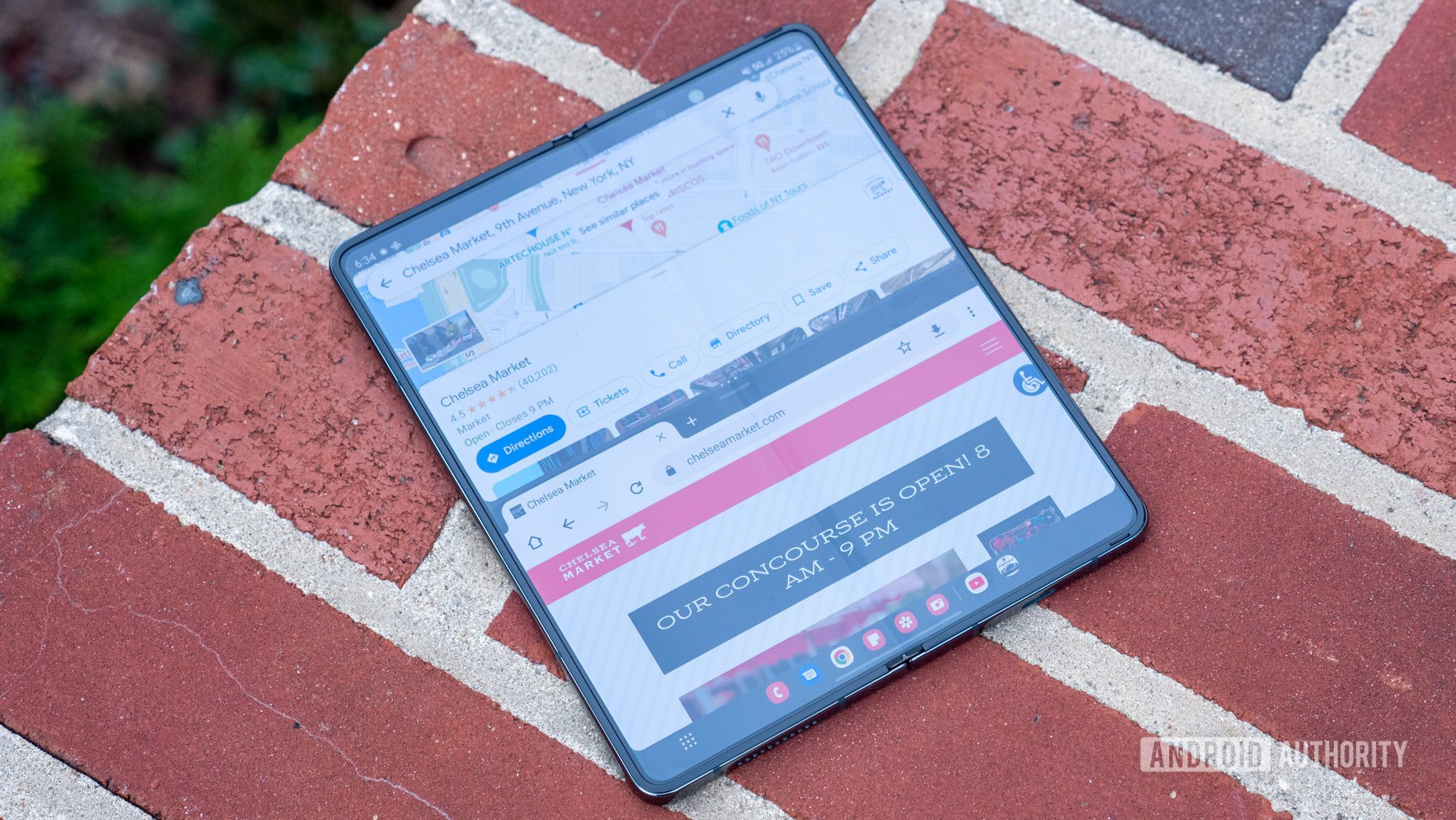
Outside of the camera upgrades, the most important change that Samsung brought to its latest Galaxy Z Fold is Android 12. Well, Android 12L, more specifically. This specialized version of Android for mobile hardware with larger displays was announced in October 2021, yet while we’ve seen it debut on a handful of Android tablets, this is the first time we’ve seen it brought to bear on a foldable device.
As soon as you open the 7.6-inch display and dive into your first app, you’re bound to notice one of Android 12L’s key features — the taskbar. It’s similar to what you’d find along the bottom of your computer screen, and it’s likely to become one of your new best friends. The taskbar tacks a few recommended apps to the left of a small vertical divider, though the list can be customized to show any apps or app folders of your choosing. Meanwhile, recently accessed apps appear on the right side of the divider. All of this is within a thumb’s reach, making them easy to open in a hurry. Even better, the nine-dot icon at the left of the taskbar opens the app drawer in case you need something that’s not already pictured.
Android 12L on the Galaxy Z Fold 4 makes multitasking feel like a curated experience.
Samsung has tinkered with the idea of optional toolbars in One UI (and in its previous Android skins) via its Edge Panel feature, but the native taskbar is far more elegantly integrated into the overall experience. Crucially, it manages to do something true to all good software changes: it makes you wonder how you could’ve ever happily used the device without it.
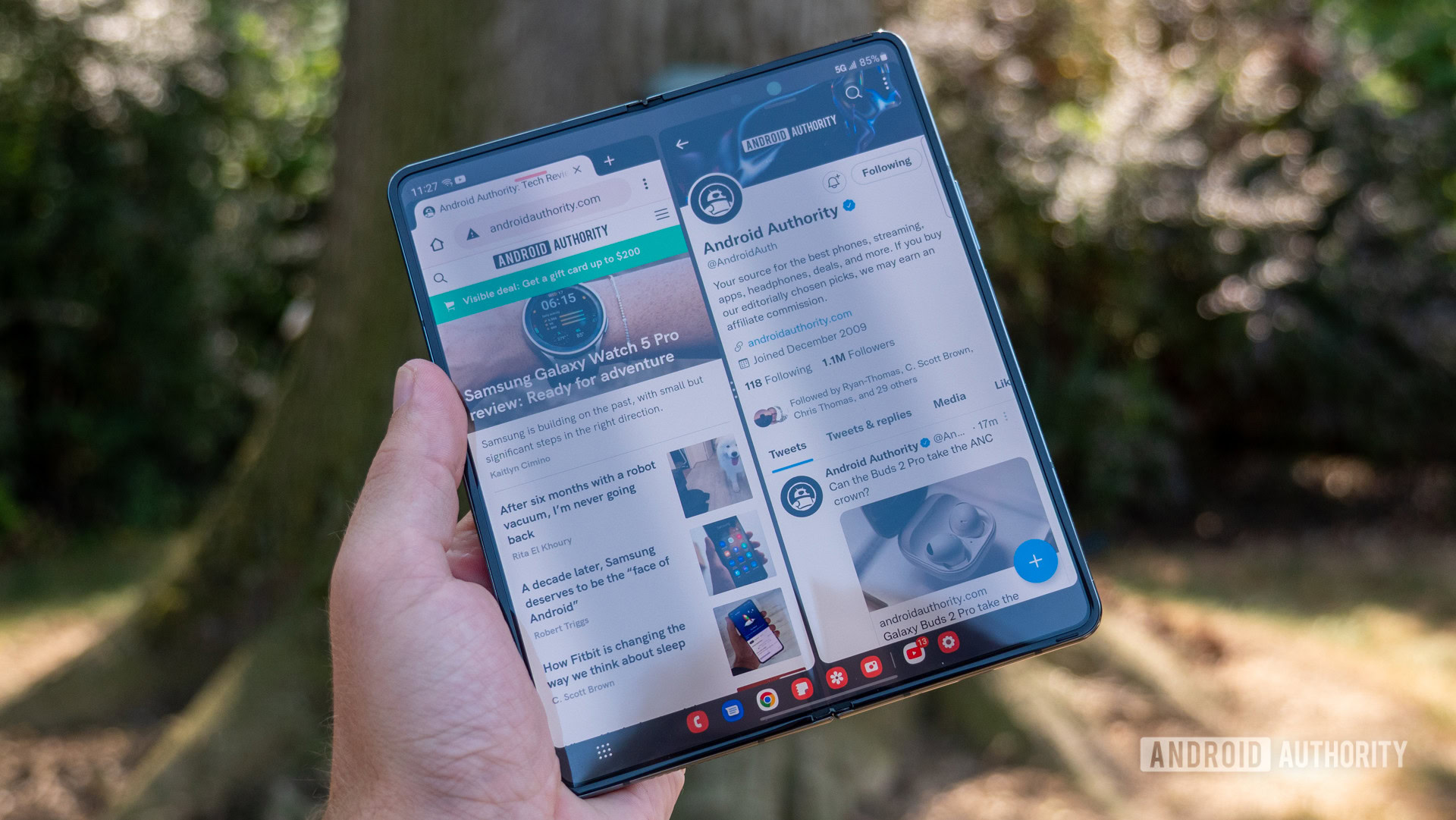
The Galaxy Z Fold 4’s taskbar leads nicely into its main purpose — multitasking. With that much screen real estate, it’s hard not to use two (or more) apps simultaneously. I generally stuck to two, but you can split the display into three small boxes to run multiple apps at the same time. As you can see above, the layout offers plenty of space for Chrome and Google Maps, making it easy to plan where you want to go for lunch and look at the menu. I also used the multitasking layout to show my cousin around his college campus while simultaneously finding his classes for the first semester in the browser.
Other Android 12L modifications seem to work best with apps from either of the two invested parties, as well as Microsoft options like OneDrive and Office thanks to Samsung’s continued partnership with the Redmond giant. In fact, some new features — such as drag-and-drop functionality to quickly copy text and images from one app to another — are specifically restricted to selected apps. Here’s hoping we see wider adoption in the near future as Android 12L’s features become a regular part of Android 13.
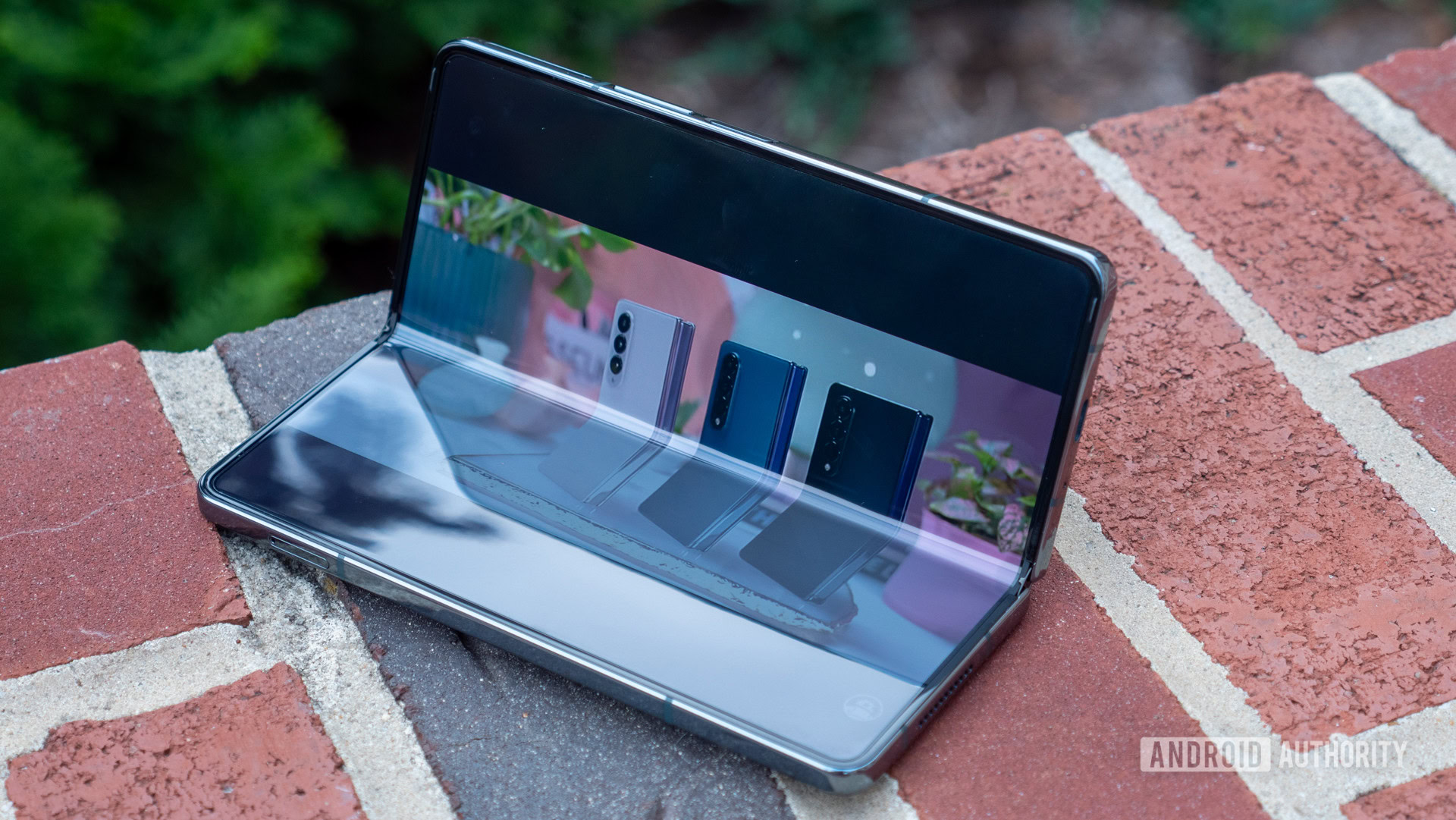
Unfortunately, not all applications are ready for this new dawn of foldable phone software brought about by Android 12L’s Adaptive UI. Some apps, like Instagram, skip the adaptation altogether, instead appearing as a window in the middle of the display that you can slide either left or right. Even Google’s own YouTube app has its weird quirks now and then. It compartmentalizes nicely if you’re watching your video in a window but gets a little dicey if you go into full-screen. Instead of bumping videos above or below the fold, it keeps them right in the center, as seen above. The image also illustrates the drawback to streaming on such a square device — thick black bars above and below your content.
It’s not a new feature, but Samsung’s split keyboard is an excellent part of One UI. Most people don’t have Shaq-sized hands, so it would be almost impossible to reach all of the keys on a standard keyboard. The Galaxy Z Fold 4, however, splits its keyboard into two thumb-sized chunks, so you don’t feel like you’re straining. You can slightly adjust the split if you prefer to reach certain keys with one hand, but I found that it makes life easier no matter which way the keys are arranged. Typing on the inner display is much more comfortable than on the cramped outer panel.
Things get even spicier if you half-fold the display and use it sat at an angle in “Flex Mode.” This shunts content to the top half and shows a keyboard, and now also a pseudo-trackpad, so you can use the Galaxy Z Fold 4 like a laptop. I’m still not really sure how practical this is, but it’s a fun option to have, I guess.
Since launch, the Galaxy Z Fold 4 has received its Android 13 update and security support up to the March 2023 security patch. You can read more on the latest software tweaks in our six-month revisit of the Galaxy Z Fold 4.
How powerful is the Samsung Galaxy Z Fold 4?
It’s not just the retooled UI that makes the Samsung Galaxy Z Fold 4 a productivity powerhouse, as it blends curated software with a hearty 12GB of RAM and Qualcomm’s finely crafted Snapdragon 8 Plus Gen 1 chipset for excellent results.
I had no problems running through daily tasks on either display, though I preferred to take advantage of the inner panel when possible. It handled all manner of app combinations that I threw at it, which made it a trusty companion for planning my time on the road. Whether I was balancing Google Maps navigation with restaurant recommendations in Chrome or bouncing between Twitter and YouTube, the Galaxy Z Fold 4 felt tuned to tackle everything at once. It does get warm occasionally, though seemingly only when I combined a heavy load with hot summer weather.
Qualcomm's Snapdragon 8 Plus Gen 1 lends the Galaxy Z Fold 4 all the power it needs to dominate as a productivity device.
Booting up Asphalt 9 told a similar story, at least for a while. The game adapted nicely to the large, relatively square display, and the controls were easy to reach. Of course, the increased demand boosted the temperature and, in turn, drained the battery, but it remained completely playable and not too hot to the touch.
When it comes to benchmarks, the Galaxy Z Fold 4 has no problems putting up stellar numbers. It scored right alongside the Galaxy Z Flip 4 on Geekbench 5 in CPU tests, with Samsung’s book-style foldable putting up numbers in the upper echelon of Snapdragon 8 Plus Gen 1 devices, and easily outgunning the OnePlus 10T — an explicitly power-focused phone — with its unlocked performance mode disabled.
The Galaxy Z Fold 4 posted equally impressive single-run scores when run through 3DMark for GPU testing, narrowly coming in behind the ASUS ROG Phone 6 Pro and again just ahead of the OnePlus 10T. However, it can’t beat the latter for sustained graphics performance when run through the Wild Life stress test gauntlet. Despite its immediate peak, this starts to drop steadily after each of the first six runs.
In terms of stability, the Galaxy Z Fold 4 can’t hold a candle to the industry-leading OnePlus 10T but there are no sharp dips like we’ve seen on Samsung phones with the vanilla Snapdragon 8 Gen 1 chip — an SoC we’ve found to generally be far less efficient than the Plus variant in our testing. In addition, the drops aren’t anywhere near as severe as those of Samsung’s other 2022 foldable, the Galaxy Z Flip 4. This suggests the Fold 4 will be a better folding companion for anyone who likes to play demanding games like the aforementioned Asphalt 9 or the notoriously power-hungry Genshin Impact for hours at a time.
Anything else?
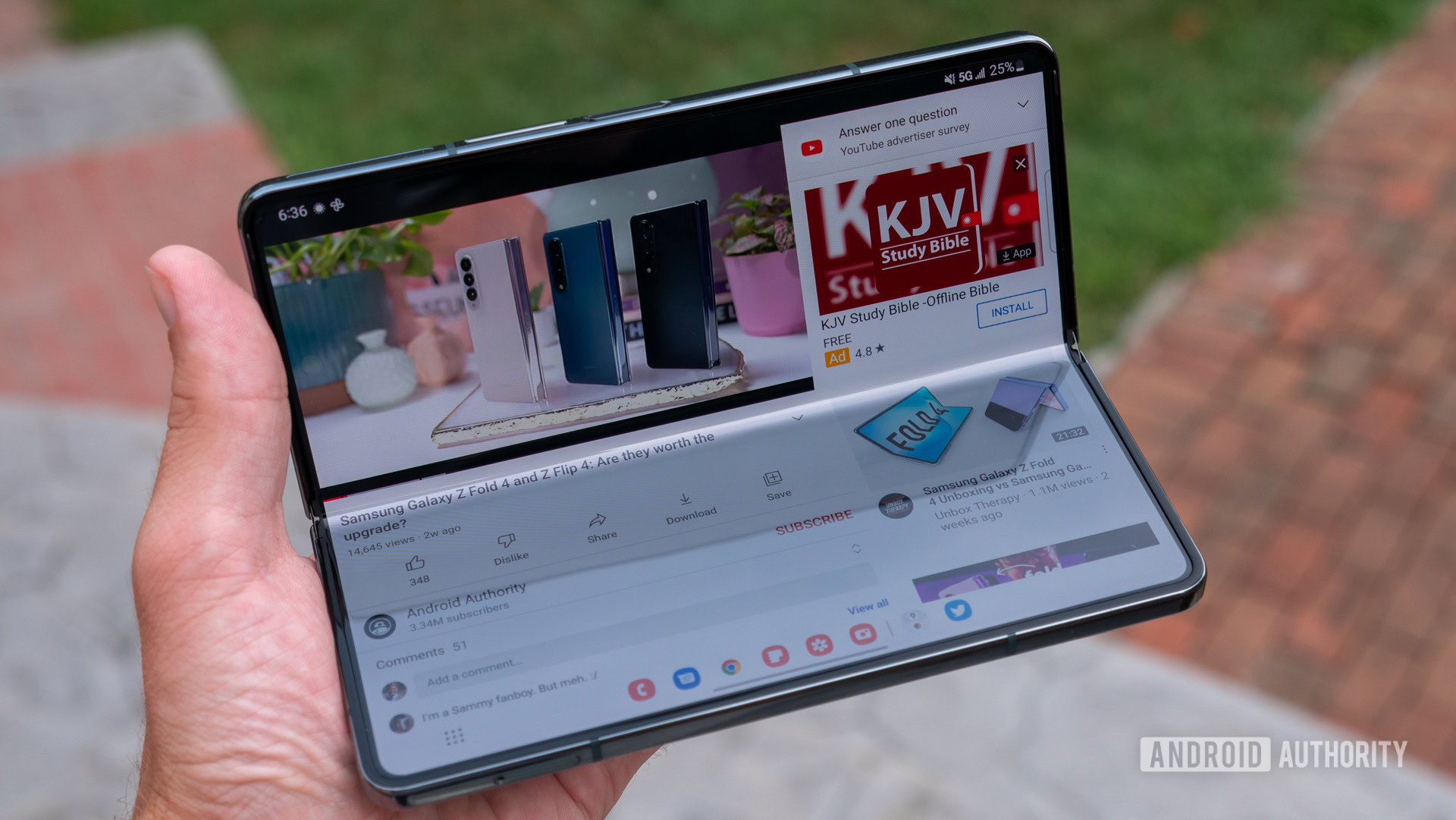
- Battery life and charging: The Galaxy Z Fold 4’s battery size and charging power is unchanged from the previous generation. You still get a 4,400mAh cell with 25W wired and 10W wireless charging, and it takes about 85 minutes to fill using a compatible USB Power Delivery PPS charger. However, the Snapdragon 8 Plus Gen 1 chip helps to stretch the charge to around five and a half hours of screen-on time with the adaptive 120Hz refresh rate enabled. It’ll go further on days where you rely on the cover screen more, but it can come up a bit short of bedtime if you exclusively use the internal display.
- Audio: The Galaxy Z Fold 4 offers a pair of prominent stereo speakers, both mounted to the left half of the Armor Aluminum frame when opened in portrait. When held this way, it can sometimes feel like most of the sound is coming from only one side. For the best results, you’ll need to rotate the display so that one speaker sits on each side instead. On the bright side, both speakers offer impressive clarity across the range. The bass suffers a bit, but not any more than it does on most flagship-tier phones.
- Biometrics: Samsung hasn’t transitioned its cutting-edge foldable to an in-display fingerprint reader yet. Instead, it’s still rocking a side-mounted capacitive sensor, and a darn good one at that. It’s not the easiest to reach with digits other than your right thumb or forefinger, but it’s quick and accurate, and it never had any issues identifying my touch.
- Connectivity: The Galaxy Z Fold 4 packs the latest connectivity standards, with Wi-Fi 6E and Bluetooth 5.2 onboard. You’ll also find NFC support for Samsung Pay (or Google Pay), and ultra-wideband for Galaxy SmartTags and other compatible accessories.
- 5G: Samsung has (mercifully) dropped the 5G affix from the Galaxy Z Fold 4’s branding, but just like its predecessor, it supports sub-6GHz and mmWave 5G networks in the US. We used the device on T-Mobile’s network without issue.
- S Pen support: The Galaxy Z Fold 4 offers support for Samsung’s powerful S Pen, though like the Galaxy Z Fold 3, you can’t just grab any old stylus from a retired Galaxy Note device or the Galaxy S22 Ultra. Instead, you’ll have to pick up the S Pen Fold Edition ($49) or S Pen Pro ($99), the latter of which packs Bluetooth support for more advanced controls. Samsung did not provide an S Pen for this review, so we were unable to put it to the test. That said, the functionality mirrors that of the Fold 3, and we did test it on Samsung’s 2021 flagship foldable. Check out our review for more details. Because it’s largely unchanged, there’s still no way to store an S Pen unless you pick up one of Samsung’s expensive Standing Cover cases ($89) that have a stylus holster, though these also come with the S Pen Fold Edition included to sweeten the deal. At this price, it’d be nice if Samsung could just include the S Pen free of charge, but alas.
- Software updates: Samsung is well-known for its unrivaled commitment to software updates, and the Galaxy Z Fold 4 is no exception. It’s set to receive four full Android version updates and five years of security coverage, which will carry the foldable through to Android 16 with security support into 2027. So far, we’ve seen an update to the June 1, 2023 security patch and official Android 13 support.
Samsung Galaxy Z Fold 4 specs
| Samsung Galaxy Z Fold 4 | |
|---|---|
Displays | Exterior: - 6.2-inch Dynamic AMOLED - 120Hz refresh rate - 2,316 x 904 resolution - Gorilla Glass Victus Plus Interior: - 7.6-inch Dynamic AMOLED - 120Hz refresh rate - 2,176 x 1,812 resolution - Foldable display covering |
Processor | Qualcomm Snapdragon 8 Plus Gen 1 |
RAM | 12GB |
Storage | 256, 512GB, or 1TB UFS 3.1 No expandable storage |
Power | 4,400mAh dual-battery 25W wired charging Fast Wireless Charging 2.0 Wireless PowerShare No charger in box |
Cameras | Exterior rear: - 50MP wide, 1.0μm, OIS, Dual Pixel AF, ƒ/1.8 - 12MP ultra-wide, 1.12μm, ƒ/2.2 - 10MP telephoto, 1.0μm, OIS, 3x zoom, ƒ/2.4 Exterior front: - 10MP ƒ/2.2, 1.22μm Internal UDC: - 4MP, 2.0μm, ƒ/1.8 |
Audio | Stereo speakers Dolby Atmos support No 3.5mm headphone port |
SIM | Dual nano-SIM tray eSIM support |
Biometrics | Side-mounted capacitive fingerprint sensor |
Software | Android 12 One UI 4.1 |
Dimensions and weight | Folded dimensions: - 155.1 x 67.1 x 15.8mm (measured at hinge) Unfolded dimensions: - 155.1 x 130.1 x 6.3mm Weight: - 263g |
Colors | Global: Graygreen, Phantom Black, Beige Samsung Exclusive: Burgundy |
Value and alternatives


Starting at a hair under $1,800, the Galaxy Z Fold 4 is the most expensive device in Samsung’s portfolio by a large margin. It balloons even further to more than $2,000 if you feel you need the top-tier 1TB version. While it’s more money than many would countenance spending on any smartphone, Samsung gets the smallest bit of credit for not raising the cost of entry during a time when many tech companies are nudging their prices up. Regardless, the unique form factor will be enough to tempt some to open their wallets awfully wide.
Like its Galaxy Z Flip 4 sibling, the Galaxy Z Fold 4 enjoys an immediate position of power in the global foldable market. Samsung still holds an iron fist over 88% of all foldable devices sold, though that total combines both of its designs. There are plenty of other book-style foldables lining up for their chance at the throne, but each one faces the same issue — availability. Unless a competitor steps up, the Galaxy Z Fold 4 will once again be the most widely distributed phone-tablet-hybrid foldable throughout the world.
Speaking of competition, Google may just give Samsung a headache in the coming months. The Google Pixel Fold ($1799 at Amazon) is the company’s first foldable phone offering and touts some alluring facets. It places a big emphasis on design, with a 12.1mm overall thickness when folded. Its hinge design allows its 7.6-inch 120Hz screen to fold flatter than the Galaxy Z Fold 4, while it’s also shorter and wider than its Korean rival, which should make its 5.8-inch outer screen more user-friendly. There’s added promise of the Pixel’s suite of camera features and the longer reach of its telephoto camera. It isn’t all sunshine and rainbows, though. Google failed to package the Pixel Fold with a stylus, and the phone isn’t easy to get a hold of due to its limited support in the US, UK, Germany, and Japan.
If you know you’re interested in a larger Samsung foldable, the newer Galaxy Z Fold 5 ($1799.99 at Samsung) makes for an obvious alternative. If you’re looking for significant differences, the Galaxy Z Fold 5 is almost identical to the Galaxy Z Fold 4 outside of its new hinge. The gapless design is very welcome, of course, as it finally means we won’t have a fine line of dust settling in the display crease — though the crease is still there. Otherwise, the two devices only really differ in the processing department, thanks to the Galaxy Z Fold 5’s overclocked Snapdragon 8 Gen 2 chipset, and slightly upgraded materials on the newer device. However, you’re bound to save some money on the Fold 4 now that it has a newer version to compete with.
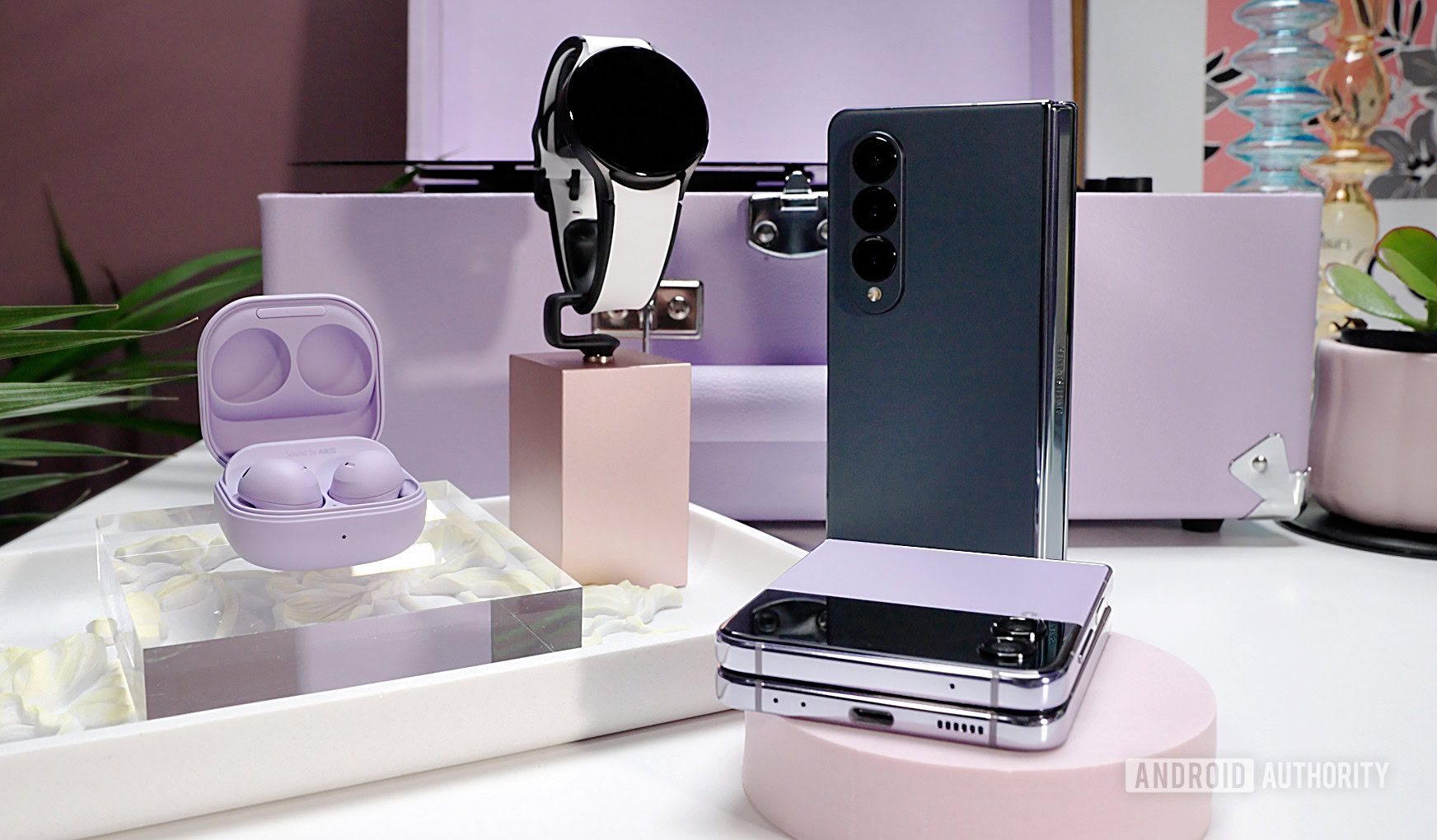
The latest-generation Galaxy Z Flip 4 ($944.45 at Amazon), on the other hand, is a great alternative if you want a foldable phone that’s comfortable in any pocket. It’s Samsung’s clamshell option, with a 6.7-inch internal display and a tiny 1.9-inch cover screen used for notifications and quick commands. Like the Galaxy Z Fold 4, it carries the Snapdragon 8 Plus Gen 1 chip inside, though its peak performance isn’t quite as sustainable in the flip form factor. The Galaxy Z Flip 4 also brings a larger 3,700mAh battery to the line for the first time. Unfortunately, the Galaxy Z Flip 4 still totes a pair of 12MP sensors, but by using the cover screen as a viewfinder, you can also use them to grab some impressive selfies.
If you’re in the UK or in selected other European regions, you can also consider HUAWEI’s Mate Xs 2 ($2705 at Amazon). HUAWEI’s offering has a single “outie” folding panel that sits at 6.5 inches when folded or 7.8 inches when you open it up. That also means there’s no refresh rate or clarity loss if you’re only using the front display. Of course, as a HUAWEI device, you’ll have to make do with Harmony OS 2 and no support for the Play Store or Google services in sight. It carries a 4G-only version of the Snapdragon 888 chipset, too, so you won’t get the fastest data speeds or the very latest in cutting-edge mobile silicon.
Prospective buyers in China have even more options, with OPPO’s Find N2 ($1499 at Giztop) and Xiaomi’s newly announced Mix Fold 2 gracing shelves. The Find N2 continues OPPO’s smaller, denser approach to the foldable game, with a shorter body and two wider displays for you to work with. Xiaomi’s Mix Fold 2 is cut from a similar cloth as Samsung’s Galaxy Z Fold lineup, but it takes advantage of the brand’s new Leica partnership for the first time on a foldable. It’s significantly slimmer than its predecessor and offers a great example of brands eliminating the display gap when Samsung still seems captivated by the crease. Similarly, tantalizing tablet-type foldables also exist from HONOR and vivo, though again, these are only available in China. OPPO is also giving the clamshell market a try with its Find N2 Flip ($1029 at Giztop), which offers a much larger cover display than most of its rivals.
Of course, there’s always a chance you’ll get this far into the review and decide that a foldable phone isn’t for you. They’re expensive, they can be finicky, and despite brands’ best efforts, they’re still not as durable as traditional slab phones. If that’s the case, and you’ve already blocked out the budget, then you’re in the territory of the industry’s elite ultra-premium phones.
The Galaxy Z Fold 4 enjoys an immediate position of power in the global foldable market.
The easiest to recommend is Samsung’s own Galaxy S23 Ultra ($1199.99 at Samsung), which would still be $100 less than the Galaxy Z Fold 4 even if you opted for the maxed out configuration with 1TB of storage. It’s as large of a traditional phone as you’re likely to find, with a hefty 6.7-inch display, and it comes with an S Pen built-in like the now defunct Galaxy Note series. You get the Snapdragon 8 Gen 2 for Galaxy chipset under the hood, and the 5,000mAh battery is built to last easily beyond a day. Likewise, while the Galaxy Z Fold 4 has made great strides with its cameras, the Galaxy S23 Ultra is currently the best camera phone in the business.
Another rival that might work for some is the Apple iPhone 14 Pro Max ($999 at Amazon). It means switching from Android to iOS, but it’s as premium of an iPhone experience as money can buy. MagSafe opened the door to a whole host of new accessories, and Apple finally swapped one of its stalwart 12MP lenses for a 48MP alternative. You should have no trouble pushing a smaller battery further, either, thanks to excellent optimization.
Samsung Galaxy Z Fold 4 review: The verdict
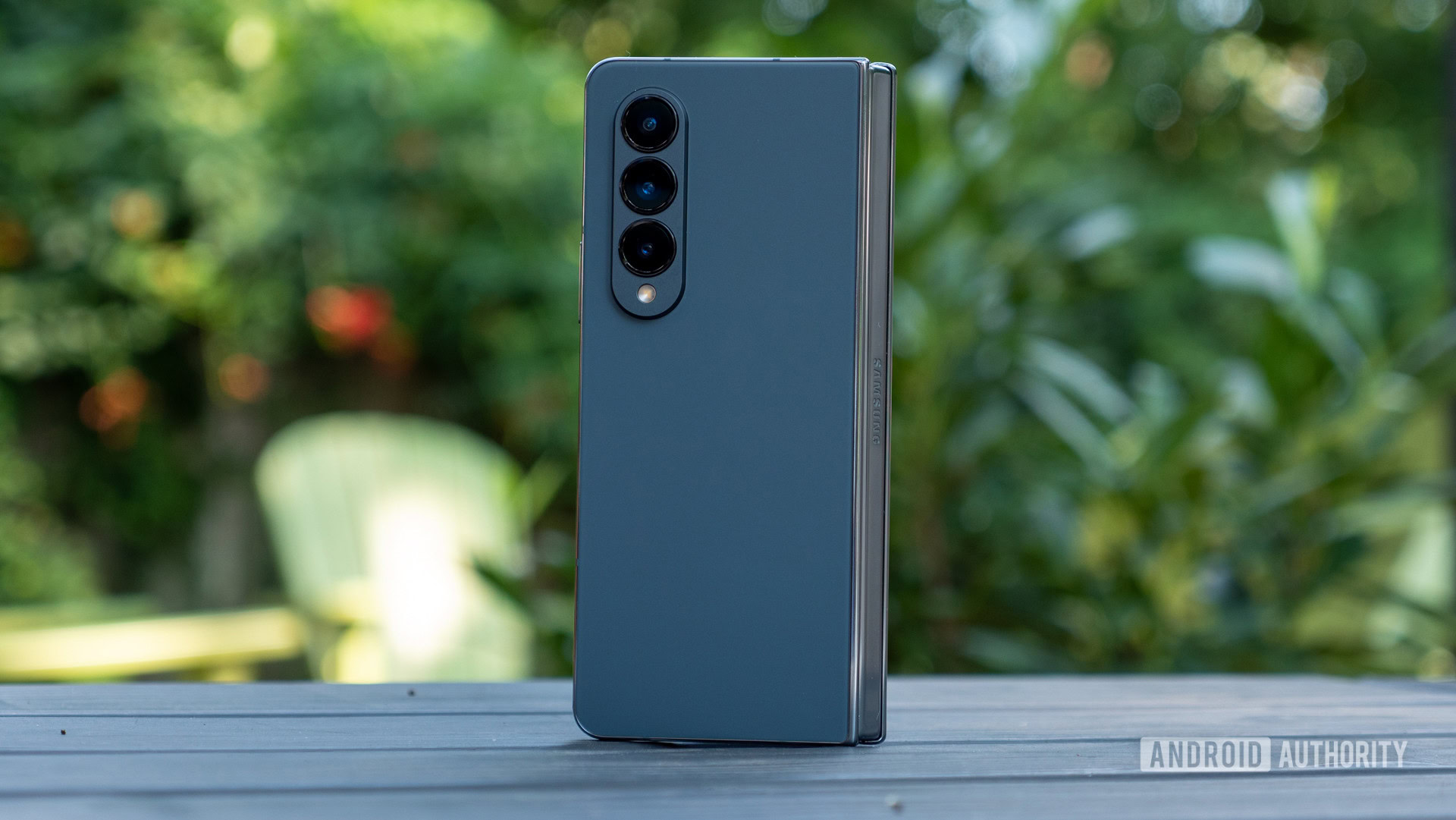
Samsung’s latest book-style foldable isn’t rebuilt — it’s refined. It brings key improvements to areas where the cutting-edge device needed them most — namely the cameras and software. The trio of rear shooters feels far more capable of living up to the exorbitant price tag, even if the measly under-display selfie option is still a “look at me” feature as opposed to being truly useful. Android 12L, however, is the key that brings the Fold together. It can bring a smile to any multitasker’s face, even if the ever-present middle crease offers a few raindrops on an otherwise sunny day.
The Galaxy Z Fold 4 doesn't reinvent the wheel, but it rolls a whole lot smoother thanks to Android 12L and its flagship-tier cameras.
As you learn to use the Galaxy Z Fold 4 in its many different configurations, it will feel like a new and powerful tool time and time again. It makes little difference that Samsung didn’t reinvent the wheel at the end of the day because the Fold remains an excellent — if expensive — technological marvel.
Samsung’s prospective competition remains limited, at least in the US, which means the Galaxy ecosystem is your best chance to try a foldable phone for at the very least another year. The company’s generous trade-in deals (at least if you already have a Samsung phone) also make it more affordable than ever to get your hands on one. While the more conservative buyers will find themselves drawn to the smaller, cheaper, and generally more practical Galaxy Z Flip 4, the Galaxy Z Fold 4 reclaims its spot as the most innovative ultra-premium smartphone available to the world at large.
Top Samsung Galaxy Z Fold 4 questions and answers
Foldable phones are more likely to break than regular slab phones. However, the Galaxy Z Fold 4’s internal display is covered by Ultra Thin Glass which is rated for up to 200,000 folds, while the phone itself is a Gorilla Glass Victus Plus sandwich with an Armor Aluminum frame. Samsung has also improved the adhesive applied to the internal display’s protective film to prevent rippling at the edges.
The Samsung Galaxy Z Fold 4 has an IPX8 rating for protection against immersion in water, though it has no rating against dust.
Yes, the Galaxy Z Fold 4 has a crease running along the center of the larger internal display where it folds. Sadly, this hasn’t improved much since the Galaxy Z Fold 3.
The Samsung Galaxy Z Fold 4 supports wireless charging though it tops out at 10-15W.
The Galaxy Z Fold 4 does not have a headphone jack.
No, you only get a USB-C cable and a SIM ejector tool. To charge it at maximum power, you will need a Power Delivery PPS charger with a 25W rating or above.
The Samsung Galaxy Z Fold 4 has a one-year warranty in the US.